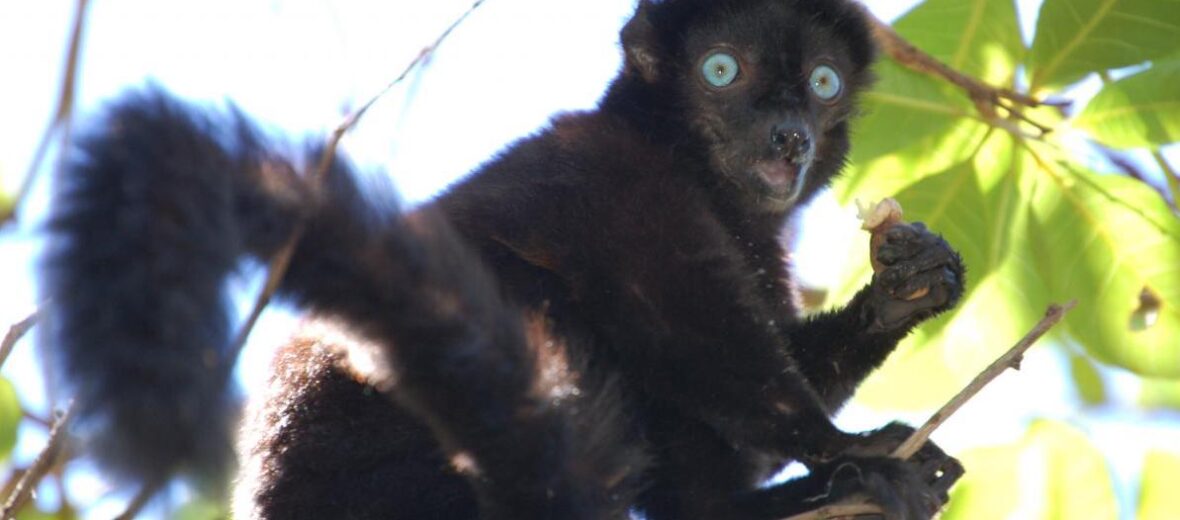
The black lemur is, like all lemurs, endemic to Madagascar. They occur nowhere else in the world, sans in zoos. These critters can be found in the riverine forests of northern Madagascar and in the rainforests, coffee, cashew nut, and timber plantations of Nosy Be and Nosy Komba. There are 2 species of black lemur: the blue eyed black lemur and the brown or orange eyed black lemur. We will be discussing black lemurs as a whole. There are a total of 103 known species of lemur living in Madagascar or the surrounding smaller islands. The brown or orange eyed black lemur is listed as Endangered and the blue eyed black lemur is listed as Critically Endangered by the IUCN, due to habitat destruction at the hands of mining and logging as well as hunting. This is my 700th critter article! Enjoy!
First the Stats…
Scientific name: Eulemur macaco
Weight: Up to 6.6 lbs.
Length: Up to 19.7 inches, plus a 23.6 inch tail
Lifespan: Up to 25 years
Now on to the Facts!
1.) This species of lemur is sexually dichromatic (the males and females are different colors) Females are brown, where the males are black.
2.) They can be found in groups called “troops” or “conspiracies” of 2 – 15 individuals.
3.) Black lemurs are heavily arboreal (spend most or all of their lives in trees).
4.) The black lemur’s society is ruled by a dominant female or matriarch. What other creatures are ruled by a matriarch? That’s right, bonobos.
5.) These lemurs are cathemeral (active both during the day and night).
But wait, there’s more on the black lemur!
6.) The black lemur eats fruit, flowers, nectar, leaves, fungi, and occasionally invertebrates. However, they are primarily known as frugivores (eat fruit) or folivores (eat leaves). On rare ground foraging expeditions, they may also eat soil, to get certain needed minerals.
7.) Black lemurs are polygynous (1 male mates with several females).
Did you know…?
Black lemurs have a habit of picking up and biting toxic red millipedes. The toxins do not seem to be fatal to the lemurs. This stimulates the millipede to release its toxic cyanide in self-defense. Once this is acquired the lemur will rub the millipede around its body to get the toxins on its fur. They do this to help repel insects and predators with the millipedes poison.
8.) In the process of self medicating with millipedes, the black lemur will also inevitably get high off the cyanide, as they bite the millipedes. They seem to enjoy this side effect and some seem almost addicted to the toxin. Another cool medicinal property of the millipedes is that ingesting the cyanide helps to kill intestinal parasites as well. Smart primates.
9.) Females birth 1 – 2 infants after a 125 day gestation (pregnancy).
10.) During the first 3 weeks, the infant(s) will cling to mom’s belly and suckle. As they age, they move to mom’s back.
But wait, there’s still more on the black lemur!
11.) At 5 – 6 months, the infants are weaned and leave the comfort of mom to venture out and explore on their own.
12.) Males typically travel from 1 group of females to another during breeding season. Naughty lemur.
Did you know…?
Lemurs play a pivotal role in culture to the Malagasy people and are the topic of many fady, or cultural taboos and traditions that hail from ancient folktales.
13.) Sans humans, lemurs are the only primate to possess blue eyes.
14.) Being frugivores (eat fruit), lemurs are crucial seed dispersers. They are, quite literally, the creators of the forests. By eating fruit, they then pass the seeds to new areas. The seed bearing fecal matter acts as fertilizer which aids in the sprouting of new plants and trees.
15.) Lemurs have been around for approximately 70 million years!
But wait, there’s still a little more on the black lemur!
16.) Black lemurs will sometimes mate with blue-eyed lemurs, to create brown-eyed infants. This is due to their territories overlapping.
17.) In Latin, lemur means, “Ghost”.
Did you know…?
Using a special gland in their wrists to scent their tail, males will undergo a silent stink war. The stinkiest male tends to be dubbed the dominant male in the troop.
18.) Many conservationists feel that ecotourism is the number 1 way to ensure the future survival of lemurs in Madagascar. It also aids in supporting the Malagasy people. Win, win.
19.) Just like humans, lemurs have flat fingernails.
20.) Each hind leg has a second toe called a toilet claw that is used for grooming purposes.
21.) A recent IUCN study showed that a whopping 98% of all lemur species are threatened with extinction. That’s approximately 103 species at risk of disappearing forever! An additional 33% are listed as Critically Endangered, which is the highest threat level before extinction. We have to do something to help them and the Malagasy people to keep a 70 million year old species from vanishing forever.
Now a Short Black Lemur Video!
Also, check out the Critter Science YouTube channel. Videos added frequently!
Want to suggest a critter for me to write about? Let me know here.



